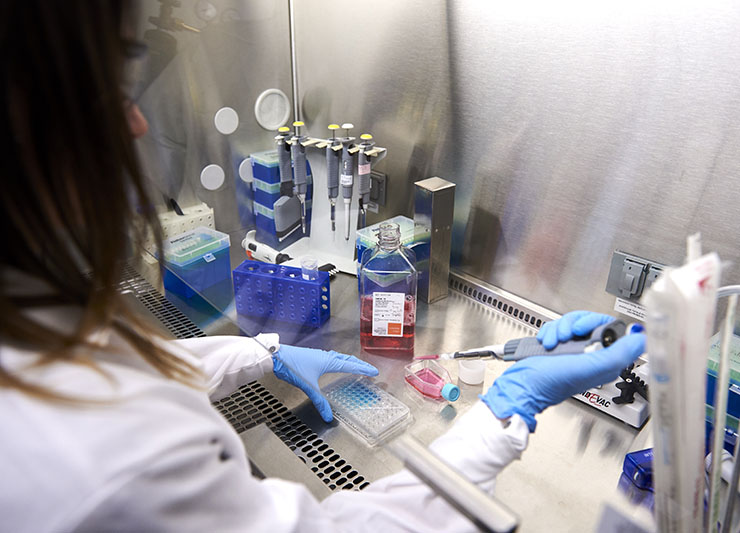Northwestern’s research enterprise has grown steadily over the past 10 years, with annual overall sponsored funding climbing about 60 percent to more than $702 million in fiscal year 2018. The University’s research efforts are designed to realize breakthroughs that benefit people’s lives and strengthen national and global security and prosperity. This research also exerts a powerful direct economic impact, a consideration important for policymakers and the public.
A new report reveals that Northwestern has contributed $796.6 million to the U.S. economy between 2009 and 2017, with spending from federal research funding flowing to 10,415 vendors and subcontractors over that time. Of these, nearly 1,500 were small businesses. Some 730 vendors were minority- or women-owned businesses, which attracted nearly $17 million in federal research spending from Northwestern.
The report is produced by the Institute for Research on Innovation and Science (IRIS), a national consortium of more than 30 research universities organized around a data repository based at the University of Michigan.
The IRIS data reflect only federal sponsored dollars as reported by Northwestern. The full economic impact of Northwestern is even greater: nonfederal and industry research funding, for example, do not factor in the IRIS report. Neither do millions in University capital investment that fuel jobs related to construction. Additional economic benefit comes from the revenue that Northwestern staff, faculty, students, and their families bring into the local economy through the purchase of various goods and services or through real estate rentals: That broader impact totals more than $130 million annually, according to Northwestern’s Neighborhood and Community Relations Office.
Even so, the IRIS data provide compelling evidence for how Northwestern’s activity contributes to a thriving economy. Between 2009 and 2017, $175 million in Northwestern federal research spending supported vendors classified in the manufacturing industry — a sector where annual wages are 67 percent higher than the national average at the companies with whom Northwestern supports. Over that same time, the educational services industry attracted even more Northwestern spending from federal sponsored sources — $204.9 million. In 2017, the most recent IRIS snapshot available for Northwestern, more than one-third (35.6 percent) of Northwestern research spending was matched to businesses in Illinois, with California, Massachusetts, New York, and Wisconsin rounding out the top five states whose economies benefited from Northwestern scientific spending that year. The top five industries receiving Northwestern federal research funds in 2017 were: educational services ($30.5 million), manufacturing ($17.8 million), health care and social assistance ($13.5 million), professional, scientific, and technical services ($7.5 million), and public administration ($6.8 million).
“When we consider these economic factors, we see that the impacts of research really occur throughout the discovery process,” said Jay Walsh, Northwestern’s vice president for research. “Through relationships with vendors and subcontractors who help us advance our work, the University is immediately contributing to the economy at the local, state, and national levels, even as our investigators remain focused on near- and longer-term research findings with the potential for transformative social and economic impact.”
IRIS was launched in 2015 with the mission to be “a trusted resource for high-quality data” that furthers research on science and innovation. The IRIS report is constructed by linking a member university’s Institutional Review Board-approved administrative data with industry data from the US Census Bureau along with workforce data from Bureau van Dijk’s Orbis dataset, which provides demographic and other details about businesses worldwide. The information that IRIS collects is de-identified to mask the identities of individual organizations; the resulting dataset is intended to help member institutions better understand and articulate the broader impacts of their research.
The impacts of research really occur throughout the discovery process.”
vice president for research
The data are also intended to help researchers interested in the social and economic effects of research investment, including topics such as entrepreneurial outcomes and human capital or questions related to science and engineering workforce and the STEM pipeline, among other subjects. Because Northwestern is an IRIS member, the University’s researchers can access the data at no charge by applying here.
For more than a decade now, Northwestern’s sponsored federal and nonfederal research awards have grown impressively — from $438.8 million in fiscal year 2008 to $702.1 million last year, which saw the University process more than $3 billion in award proposals and be awarded nearly 3,400 research grants.
Northwestern’s economic impact also includes many capital investments in buildings and infrastructure essential for research, teaching, and the student experience. These efforts spur local job creation, drive spending in the Evanston economy, and generate funds for the city of Evanston and Chicago through related permits.
Between 2011 and 2016, the University paid $25 million in construction fees to the city of Evanston, supporting the city’s functions and services. Similarly, in Chicago, Northwestern’s recently opened 12-story Simpson Querrey Biomedical Research Center is expected to produce an additional $150 million in annual sponsored research funding ($1.5 billion over 10 years) and generate an estimated $390 million annually to the local economy. The state-of-the-art building’s first phase already created more than 2,500 construction jobs. The design of the building plans for up to 16 additional new floors in a second phase of development.
“While this center’s [research] impact will be global, many of its benefits are intentionally local,” said Northwestern President Morton Schapiro at the building’s formal opening in June. “It will serve as an economic engine within Chicago, working with nearby partners from education, business and government to create new opportunities for so many people who call this region home.”
Matt Golosinski is director of research communications in the Office for Research.


